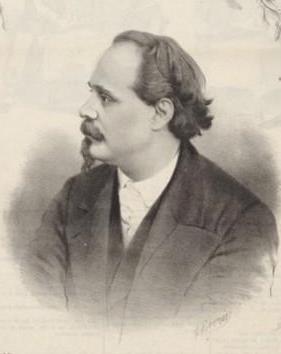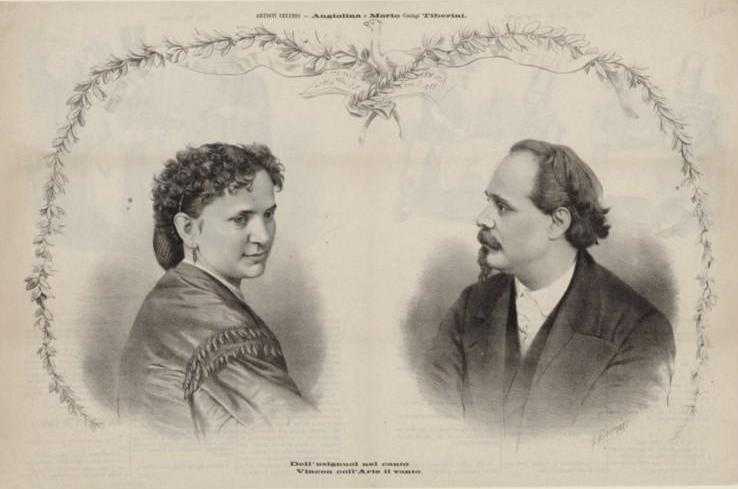Mario Tiberini on:
[Wikipedia]
[Google]
[Amazon]
 Mario Tiberini (8 September 1826 – 16 October 1880) was an Italian
Mario Tiberini (8 September 1826 – 16 October 1880) was an Italian
 After his return to Europe in 1858, Tiberini was engaged as ''primo tenore'' at the Gran Teatre del Liceu in Barcelona. There he met and fell in love with the soprano Angiolina Ortolani who was singing the title role in ''
After his return to Europe in 1858, Tiberini was engaged as ''primo tenore'' at the Gran Teatre del Liceu in Barcelona. There he met and fell in love with the soprano Angiolina Ortolani who was singing the title role in ''
 Mario Tiberini (8 September 1826 – 16 October 1880) was an Italian
Mario Tiberini (8 September 1826 – 16 October 1880) was an Italian tenor
A tenor is a type of classical male singing voice whose vocal range lies between the countertenor and baritone voice types. It is the highest male chest voice type. The tenor's vocal range extends up to C5. The low extreme for tenors i ...
who sang leading roles in the opera houses of Europe and the Americas in a career spanning 25 years. Known for his advanced singing technique and dramatic ability, he sang the role of Alvaro in the premiere of the revised (and now standard) version of Verdi's ''La forza del destino
' (; ''The Power of Fate'', often translated ''The Force of Destiny'') is an Italian opera by Giuseppe Verdi. The libretto was written by Francesco Maria Piave based on a Spanish drama, ' (1835), by Ángel de Saavedra, 3rd Duke of Rivas, ...
'' and created several roles in operas by lesser-known composers, including the title role in Faccio's ''Amleto
''Amleto'' is an opera in four acts by Franco Faccio set to a libretto by Arrigo Boito, based on Shakespeare's play ''Hamlet''. It premiered on 30 May 1865 at the Teatro Carlo Felice in Genoa and was revised for a La Scala production given on 1 ...
''.
Life and career
Tiberini was born inSan Lorenzo in Campo
San Lorenzo in Campo is a ''comune'' (municipality) in the Province of Pesaro e Urbino in the Italian region Marche, located about west of Ancona and about south of Pesaro.
The main attraction is the Gothic church of San Lorenzo, once part of a ...
in Italy's Marche region
Marche ( , ) is one of the twenty regions of Italy. In English, the region is sometimes referred to as The Marches ( ). The region is located in the central area of the country, bordered by Emilia-Romagna and the republic of San Marino to the ...
. After study in Rome with Domenico Lucilla and in Naples with Emanuele de Roxas, he made his stage debut in 1851 as Idreno in Rossini's ''Semiramide
''Semiramide'' () is an opera in two acts by Gioachino Rossini.
The libretto by Gaetano Rossi is based on Voltaire's tragedy ''Semiramis'', which in turn was based on the legend of Semiramis of Assyria. The opera was first performed at La Fenic ...
'' at Rome's Teatro Argentina
The Teatro Argentina (directly translating to "Theatre Argentina") is an opera house and theatre located in Largo di Torre Argentina, a square in Rome, Italy. One of the oldest theatres in Rome, it was constructed in 1731 and inaugurated on 31 ...
. He performed in a few provincial theatres in Italy until 1854 when he toured North and South America with Italian opera companies. He also gave solo concerts in New York and Boston launched by the opera impresario Bernard Ullman who billed Tiberini as a descendant of the Roman Emperor Tiberius
Tiberius Julius Caesar Augustus (; 16 November 42 BC – 16 March AD 37) was the second Roman emperor. He reigned from AD 14 until 37, succeeding his stepfather, the first Roman emperor Augustus. Tiberius was born in Rome in 42 BC. His father ...
.Guerra, Giosetta (2005). ''Mario Tiberini, tenore (1826–1880): Una gloria marchigiana del passato'', pp. 19; 324–334. Associazione musicale Mario Tiberini Celletti, Rodolfo (1989). ''Voce di tenore'', pp. 147–148. IdeaLibri.
 After his return to Europe in 1858, Tiberini was engaged as ''primo tenore'' at the Gran Teatre del Liceu in Barcelona. There he met and fell in love with the soprano Angiolina Ortolani who was singing the title role in ''
After his return to Europe in 1858, Tiberini was engaged as ''primo tenore'' at the Gran Teatre del Liceu in Barcelona. There he met and fell in love with the soprano Angiolina Ortolani who was singing the title role in ''Linda di Chamounix
''Linda di Chamounix'' is an operatic ''melodramma semiserio'' in three acts by Gaetano Donizetti. The Italian libretto was written by Gaetano Rossi. It premiered in Vienna, at the Kärntnertortheater, on 19 May 1842.
Performance history
'' ...
''. They married soon after and for the rest of their careers, appeared together in many operas. By 1875, Tiberini's voice began showing signs of decline, and shortly afterwards he also began showing symptoms of mental illness. He spent his final days in a sanatorium in Reggio Emilia
Reggio nell'Emilia ( egl, Rèz; la, Regium Lepidi), usually referred to as Reggio Emilia, or simply Reggio by its inhabitants, and known until 1861 as Reggio di Lombardia, is a city in northern Italy, in the Emilia-Romagna region. It has abou ...
where he died at the age of 54. An inscription on a lithograph in the in Milan states that he died believing he was Manrico, the protagonist of ''Il trovatore
''Il trovatore'' ('The Troubadour') is an opera in four acts by Giuseppe Verdi to an Italian libretto largely written by Salvadore Cammarano, based on the play ''El trovador'' (1836) by Antonio García Gutiérrez. It was García Gutiérrez's mo ...
''. However, according to Denise Gallo writing in ''The Cambridge Verdi Encyclopedia'', there is no mention of this delusion in the records of the asylum, and it may well be a theatrical legend.
Tiberini was buried in the Cimitero Monumentale di Milano
The Cimitero Monumentale (" Monumental Cemetery") is one of the two largest cemeteries in Milan, Italy, the other one being the Cimitero Maggiore. It is noted for the abundance of artistic tombs and monuments.
Designed by the architect Carlo Ma ...
. The funerary sculpture on his grave is by Pietro Fumeo (1831–1898) and depicts a broken column entwined with ivy. The inscription lists his greatest roles: Edgardo
Edgardo is an Italian-language form of the name Edgar. It may refer to:
*Edgardo Abdala (born 1978), Chilean-Palestinian football midfielder
*Edgardo Adinolfi (born 1974), Uruguayan football player
*Edgardo Alfonzo (born 1973), former Major League ...
, Arturo Arturo is a Spanish and Italian variant of the name Arthur.
People
* Arturo Álvarez (footballer, born 1985), American-born Salvadoran footballer
*Arturo Álvarez (footballer, born 1959), Mexican footballer
*Arthuro Henrique Bernhardt (b. 1982), Br ...
, Corradino, Raul
Raul, Raúl and Raül are the Italian, Portuguese, Romanian, Spanish, Galician, Asturian, Basque, Aragonese, and Catalan forms of the Anglo-Germanic given name Ralph or Rudolph. They are cognates of the French Raoul.
Raul, Raúl or Raül may re ...
, Lohengrin
Lohengrin () is a character in German Arthurian literature. The son of Parzival (Percival), he is a knight of the Holy Grail sent in a boat pulled by swans to rescue a maiden who can never ask his identity. His story, which first appears in Wolf ...
, and Alvaro. In 1880, four months after his death, the Teatro Trionfo in San Lorenzo in Campo
San Lorenzo in Campo is a ''comune'' (municipality) in the Province of Pesaro e Urbino in the Italian region Marche, located about west of Ancona and about south of Pesaro.
The main attraction is the Gothic church of San Lorenzo, once part of a ...
was renamed the in his honour as was the street on which it stands.
Roles created
*Arnaldo in Nicolás Guañabens' ''Arnaldo de Erill'', Gran Teatre del Liceu, Barcelona, 12 May 1859Role creations sourced from Casaglia *Gino inAchille Peri
Achille Peri (20 December 1812 – 28 March 1880) was an Italian composer and conductor. He is best known for his operas which were strongly influenced by the music of Giuseppe Verdi.
Life and career
Born in Reggio Emilia, Peri began his musical ...
's ''L'espiazione'', La Scala, Milan, 7 February 1861
*Amleto in Franco Faccio
Francesco (Franco) Antonio Faccio (8 March 1840 – 21 July 1891) was an Italian composer and conductor. Born in Verona, he studied music at the Milan Conservatory from 1855 where he was a pupil of Stefano Ronchetti-Monteviti and, as scholar Will ...
's ''Amleto
''Amleto'' is an opera in four acts by Franco Faccio set to a libretto by Arrigo Boito, based on Shakespeare's play ''Hamlet''. It premiered on 30 May 1865 at the Teatro Carlo Felice in Genoa and was revised for a La Scala production given on 1 ...
'', Teatro Carlo Felice
The Teatro Carlo Felice is the principal opera house of Genoa, Italy, used for performances of opera, ballet, orchestral music, and recitals. It is located on the side of Piazza De Ferrari.
The hall is named for King Carlo Felice, and dates fro ...
, Genoa, 30 May 1865
*Romeo in Filippo Marchetti
Filippo Marchetti (26 February 1831, Bolognola, Macerata – 18 January 1902, Rome) was an Italian opera composer. After studying in Naples, his first opera was "successfully premiered"Holden, Amanda (Ed.), pp. 528/29 in Turin in 1856. Wit ...
's ''Romeo e Giulietta'', Teatro Grande
The Teatro Grande is the main performance venue for the city of Brescia, Italy. The venue hosts performances of operas, musicals, plays, concerts, ballet, modern dance
Modern dance is a broad genre of western concert or theatrical dance whi ...
, Trieste, 25 October 1865
*Don Diego in Giovanni Pacini
Giovanni Pacini (11 February 17966 December 1867) was an Italian composer, best known for his operas. Pacini was born in Catania, Sicily, the son of the buffo Luigi Pacini, who was to appear in the premieres of many of Giovanni's operas. The ...
's ''Don Diego de' Mendoza'', La Fenice
Teatro La Fenice (, "The Phoenix") is an opera house in Venice, Italy. It is one of "the most famous and renowned landmarks in the history of Italian theatre" and in the history of opera as a whole. Especially in the 19th century, La Fenice bec ...
, Venice, 12 January 1867
*Comte d'Alteriva in Józef Poniatowski
Prince Józef Antoni Poniatowski (; 7 May 1763 – 19 October 1813) was a Polish general, minister of war and army chief, who became a Marshal of the French Empire during the Napoleonic Wars.
A nephew of king Stanislaus Augustus of Poland (), P ...
's ''La contessina'', Théâtre des Italiens, Paris, 28 April 1868
*Ruy Blas in Filippo Marchetti's ''Ruy Blas'', La Scala, Milan, 3 April 1869
References
External links
* {{DEFAULTSORT:Tiberini, Mario Italian operatic tenors 1826 births 1880 deaths People from the Province of Pesaro and Urbino 19th-century Italian male opera singers Burials at the Cimitero Monumentale di Milano